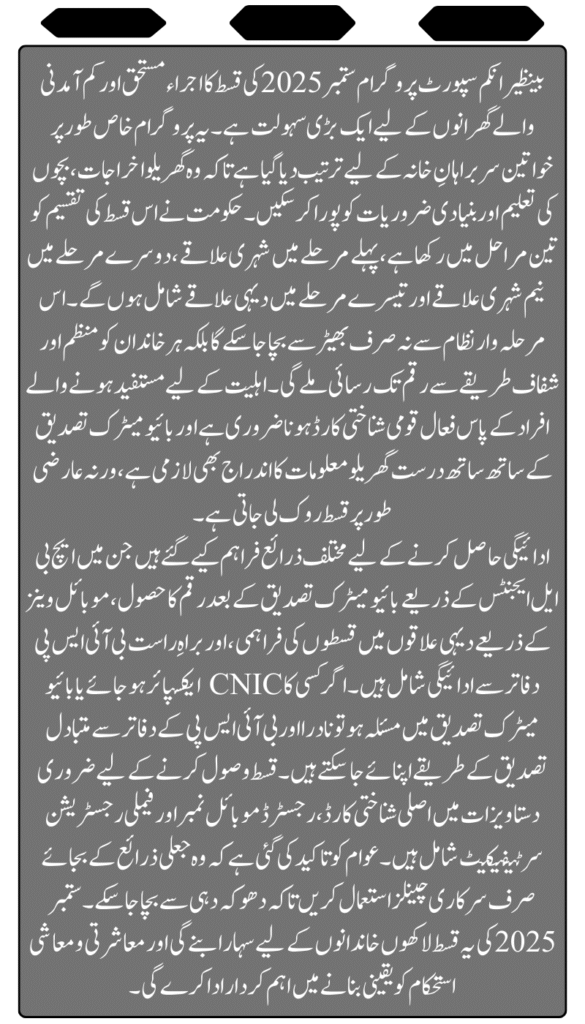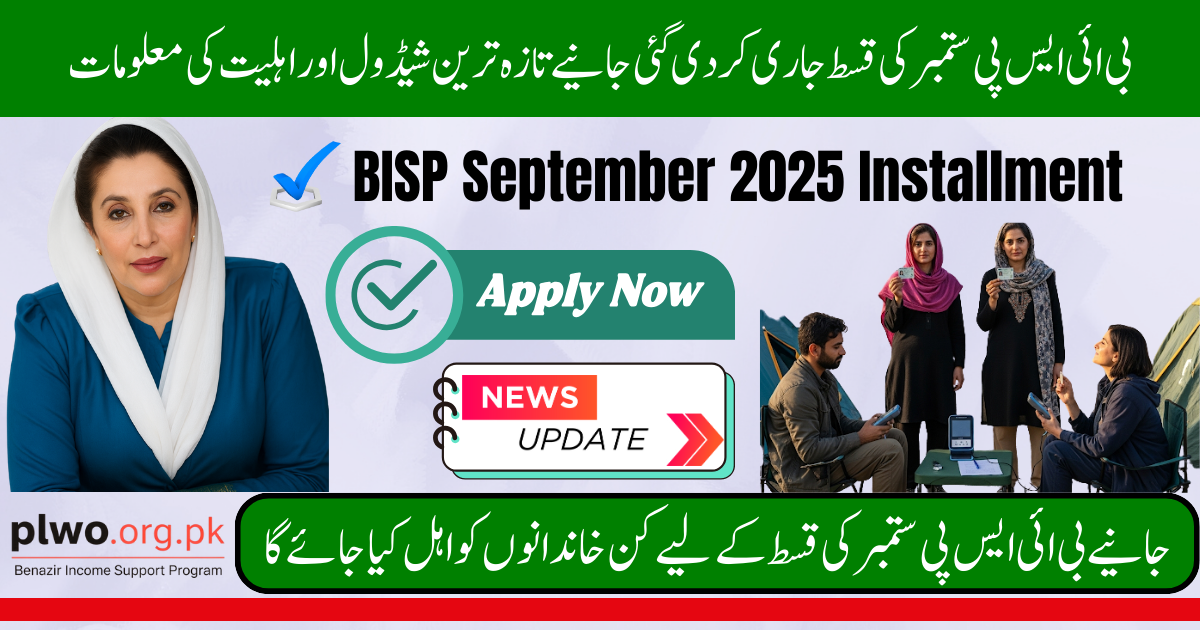BISP September 2025 Installment
BISP September 2025 Installment marks another crucial step in the government’s effort to support vulnerable families across Pakistan. As part of the Benazir Income Support Program, this quarterly release aims to reduce poverty and alleviate financial burdens for low-income households. With rising inflation and increasing living costs, the September 2025 installment provides timely relief to millions of deserving women and families, ensuring they can manage essential needs such as food, healthcare, and education.

This September installment is particularly significant because it continues the government’s focus on supporting women beneficiaries and marginalized families. By providing systematic and transparent cash disbursements, the program ensures that registered women and households can meet essential expenses like food, healthcare, and children’s education without falling deeper into financial distress.
You can also read: 8171 Ehsaas Program 25000 CNIC Check Online 2025
Objectives of the September 2025 BISP Installment
The core purpose of the September 2025 installment is to provide direct financial assistance to vulnerable communities. These payments serve as a financial cushion for families who would otherwise struggle to manage household needs due to inflation and limited income opportunities.
A key objective of this cycle is also to maintain consistency in the distribution system. Through phased disbursement across urban, semi-urban, and rural regions, BISP ensures a fair and organized approach. This system reduces pressure on payment centers and makes it easier for beneficiaries to receive funds without delays or overcrowding.
Updated Eligibility Criteria for September 2025
Before receiving the September 2025 installment, beneficiaries must fulfill certain eligibility conditions. These requirements help BISP identify the most deserving families while ensuring that resources are not misused.
Eligibility is largely dependent on the Poverty Means Test (PMT) score, updated registration data, and household verification records. Women are prioritized as the heads of families, making this program especially critical in empowering female beneficiaries who play a central role in managing household budgets.
You can also read: BISP Payment September 2025 Online Registration
Who Qualifies for the September 2025 BISP Installment?
To qualify for the September installment, applicants must ensure that their documents are valid and their household data matches BISP records. Beneficiaries with expired or incorrect information may be temporarily excluded until corrections are made.
Households already registered under BISP should confirm their eligibility before attempting to collect the installment. This step avoids unnecessary travel to payment centers and ensures a smoother collection process for everyone.
September 2025 BISP Installment Payment Schedule
Payments for September 2025 are being released in three clear phases to handle the large number of beneficiaries across Pakistan. This strategy helps reduce congestion at collection points and guarantees that beneficiaries are served in an organized manner.
- Phase 1 is scheduled for the first week of September and will mainly cover urban areas where systems are more developed and verification is quicker.
- Phase 2 will run during the second and third weeks of September, focusing on semi-urban regions.
- Phase 3 will take place in the final week of September, targeting rural families and those awaiting final verification updates.
You can also read: Punjab Launches Electric Bike Program for Female
Methods to Check BISP September 2025 Eligibility
Beneficiaries can confirm their installment status before visiting payment points. The government has introduced multiple digital and in-person methods to make this process easier and more transparent.
The most popular method is the 8171 SMS service, where beneficiaries send their CNIC number to 8171 for instant confirmation. Additionally, the BISP online portal provides real-time updates for those with internet access. In rural regions, mobile vans and BISP field offices also offer verification services to ensure inclusivity.
Payment Collection Methods for September 2025
Once eligibility is confirmed, beneficiaries can collect their payments using several channels. This multiple-option system provides flexibility and ensures outreach across both urban and rural areas.
For most beneficiaries, HBL agents are the primary payment point, where biometric verification ensures secure and immediate cash withdrawal. Rural families can access mobile vans that bring payments directly to local communities. In cases of biometric issues, beneficiaries are directed to nearby BISP offices for alternative verification and collection.
You can also read: BISP Web Portal 8171 Check Your Eligibility and Payment Status
Documents Required for Payment Collection
Document verification is a critical step to maintain program transparency. Beneficiaries must carry their original Computerized National Identity Card (CNIC), as biometric verification cannot be completed without it. Additionally, a registered mobile number linked to BISP records is necessary for SMS alerts and verification messages.
Families are also encouraged to keep their Family Registration Certificate (FRC) updated, as household data mismatches are a common cause of delays. Preparing these documents in advance avoids unnecessary hurdles during payment collection.
Common Issues and Solutions for Beneficiaries
Like any large-scale program, BISP beneficiaries may face certain challenges during the installment process. However, the government has outlined clear solutions to reduce inconvenience.
One of the most common issues is CNIC expiry. Beneficiaries are strongly advised to renew their CNICs at NADRA centers to prevent disqualification. Biometric mismatches are another frequent issue, but BISP provides alternative face verification methods to overcome this. Household data errors, such as incorrect mobile numbers or family details, can be updated through BISP offices or mobile vans.
You can also read: CM Punjab Bike Scheme 2025 Online Application and Registration Process
Government Channels Ensuring Transparency
The government has introduced multiple support channels to maintain program credibility. These include official helplines, awareness campaigns, and strict monitoring of agents. Mobile vans are particularly useful for remote areas, ensuring that rural families do not need to travel long distances to collect funds.
Awareness drives are also being conducted to warn beneficiaries against fraudulent schemes and ensure that they rely only on official BISP channels. This strengthens the trust of families in the program and reduces the risk of exploitation.
Eligibility Criteria for Beneficiaries
- Must be a registered BISP beneficiary with an active CNIC
- Only women heads of households are considered eligible
- Family income must fall below BISP’s prescribed threshold
- Biometric and mobile number verification required
- Expired CNICs and incorrect data may result in disqualification
You can also read: BISP Benazir Kafaalat Program New Payment Update August–September 2025
September 2025 Payment Schedule
- Phase 1: First week of September, urban areas
- Phase 2: Second and third week, semi-urban areas
- Phase 3: Final week, rural beneficiaries and pending verifications
Payment Collection Methods
- Withdraw cash from HBL bank agents after biometric verification
- Collect payments from BISP mobile vans in rural areas
- Receive funds from BISP offices in case of biometric failure
You can also read: Total Number of Tractors to Be Distributed in CM Punjab Green Tractor Scheme Phase 2
Required Documents for Collection
- Original CNIC
- Registered mobile number
- Family Registration Certificate (FRC)
Conclusion
The BISP September 2025 Installment Release plays a vital role in supporting families struggling with rising expenses. By ensuring eligibility, updating documents, and following official verification methods, beneficiaries can receive their payments without hurdles. The government’s phased approach guarantees smooth distribution, while support channels reduce challenges for families in both urban and rural areas.
For millions of women and low-income households, this installment is more than just financial aid, it is a symbol of stability, empowerment, and social support at a critical time.
You can also read: PM Laptop Scheme 2025 Policy Changed in August Latest Update for Students
